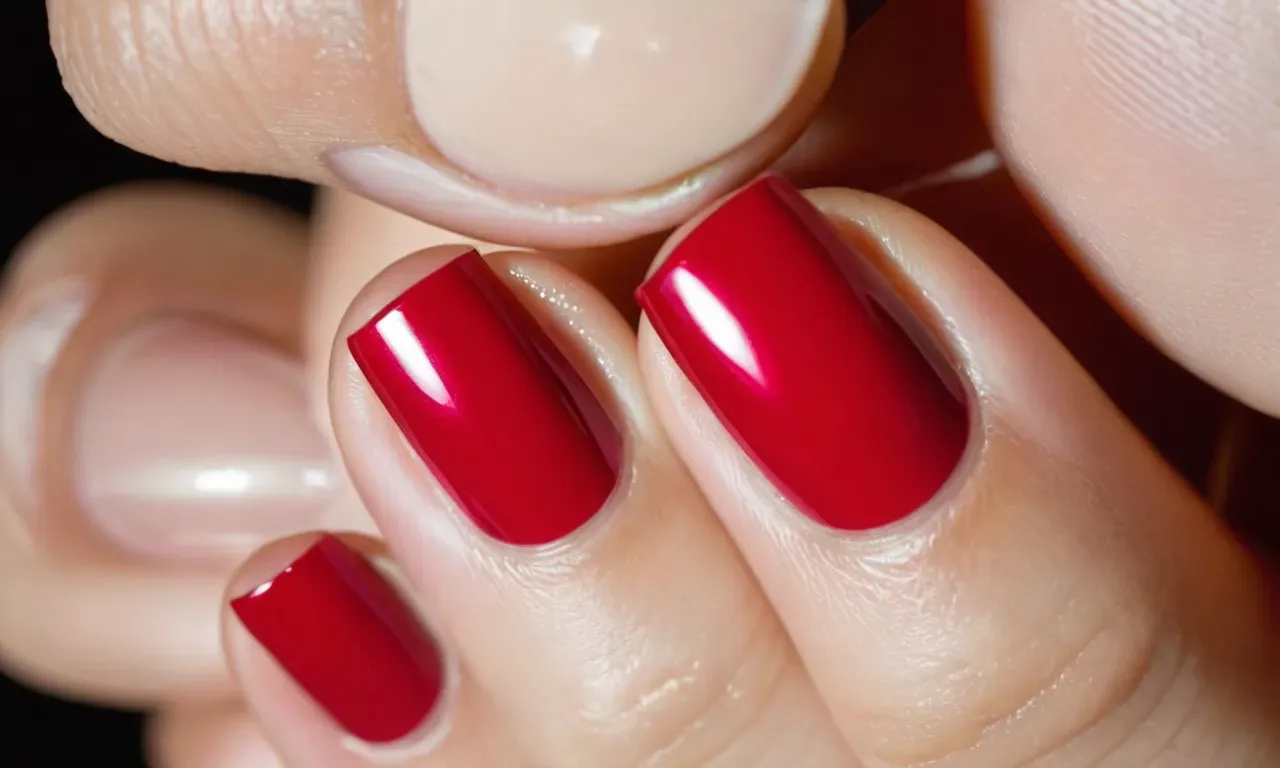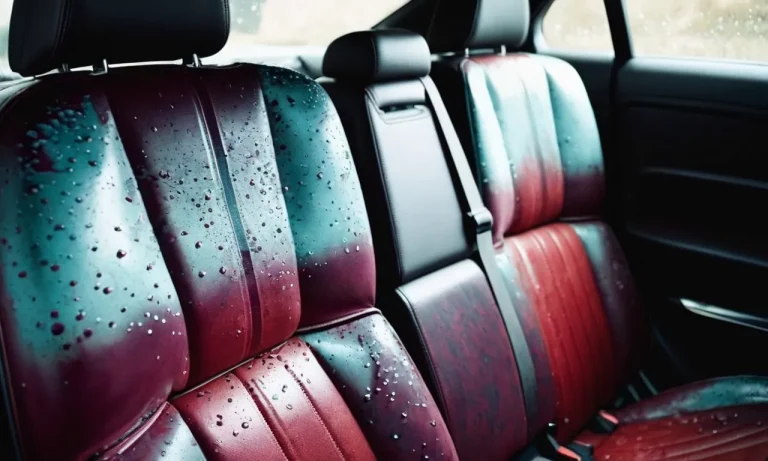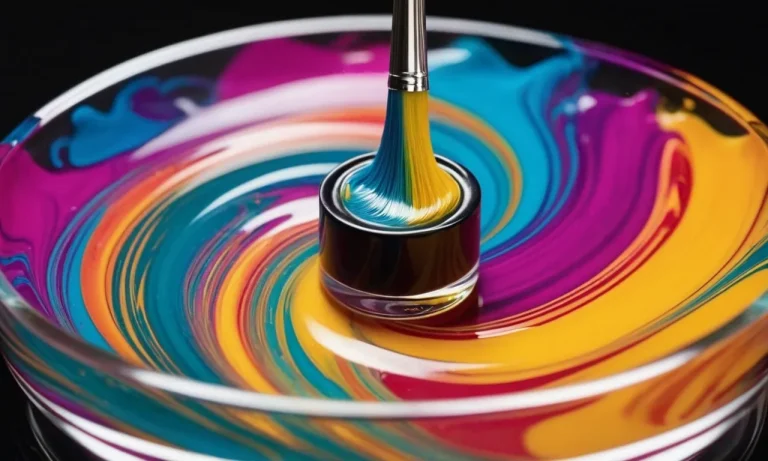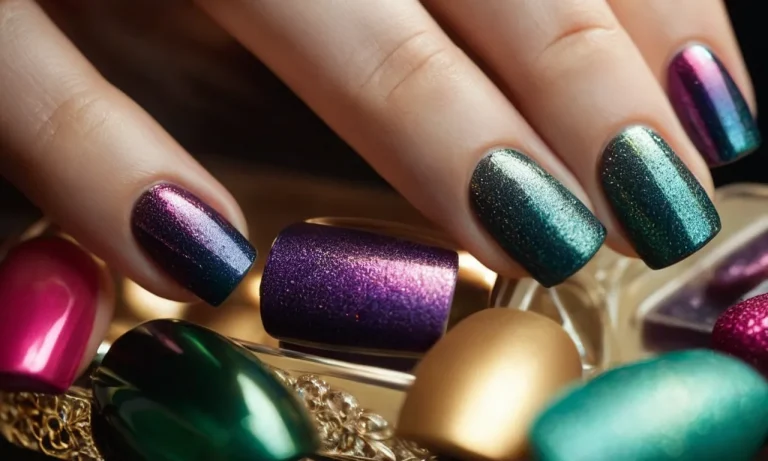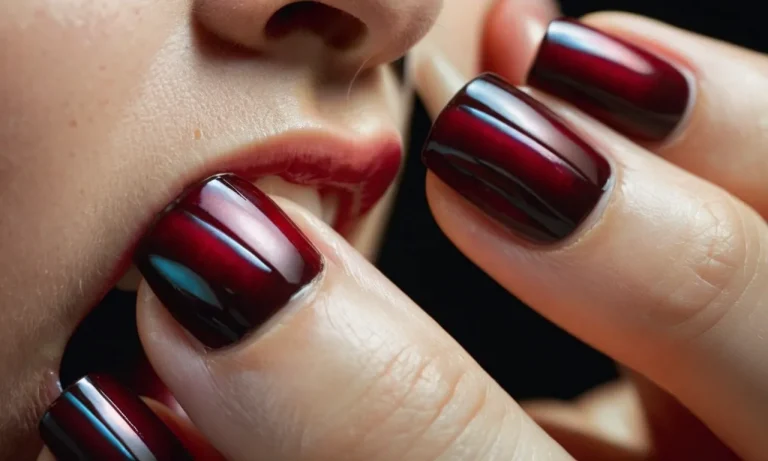What Is Gel Nail Polish? A Comprehensive Guide
With so many nail polish options on the market, gel nail polish has become one of the most popular choices for its durability and long-lasting color. If you’ve ever wondered what exactly gel nail polish is and how it differs from regular nail polish, this comprehensive guide will provide all the details you need.
If you’re short on time, here’s a quick answer: Gel nail polish is a type of long-lasting manicure product that uses a gel base and needs to be ‘cured’ under UV or LED light to set and harden on the nails.
In this detailed guide, we’ll cover everything you need to know about gel nail polish including what it’s made of, how it’s applied and removed, its pros and cons compared to regular polish, and some of the most popular gel polish brands on the market today.
What is Gel Nail Polish Made Of?
Polymer Base
Gel nail polishes have a unique polymer base that gives them their durable, long-lasting finish. The main ingredients in the polymer base are:
- Methacrylate polymers – These provide adhesion, flexibility, and durability. Common methacrylate monomers used are ethyl methacrylate (EMA), hydroxyethyl methacrylate (HEMA), and butyl methacrylate (BMA).
- Polyurethane acrylate oligomers – These oligomers provide glossy finish and thickness to the polish. They also enhance flexibility and durability.
Additional minor components in the polymer base that improve performance:
- Adhesion promoters – Increase bonding between the natural nail plate and the gel polish.
- Inhibitors – Prevent premature polymerization of monomers.
- Silica and clay fillers – Enhance thickness, durability and opacity.
The polymer base allows gel polishes to last 2-3 weeks without chipping or peeling with proper application. The polymers form cross-linked structures when cured under LED or UV light, creating a protective layer adhered to the natural nail.
Photoinitiators
Photoinitators are light-sensitive compounds that initiate polymerization when exposed to UV and visible light. They transform gel polish from a thick liquid to a hard, durable solid upon light exposure. The two main photoinitiators used are:
- Benzophenone – The most commonly used photoinitiator in gel systems. It effectively polymerizes gel components when exposed to UV and LED light.
- Phosphine oxide – Used in LED gel polishes. It cures quicker than benzophenone under LED light.
Most gel nail polish systems use a combination of both photoinitators for quick, thorough curing under LED lamps. The type and concentration of photoinitiator affects the curing time and hardness of the cured gel polish film. Using the right balance is crucial for an even, long-lasting manicure.
How is Gel Nail Polish Applied?
Prep and Base Coat
Applying gel nail polish begins with proper nail prep. First, trim and file the natural nails into the desired shape. Use a nail dehydrator or wipe nails with alcohol to remove oils and prep the nails for polish. Next, apply a gel nail primer or bond to help the gel adhere to the nail plate.
After priming, apply a gel base coat in thin, even layers and cure under an LED or UV lamp for 30-60 seconds. The gel base coat helps bond layers of color and provides an even surface.
Color Application
After prepping the nails and applying a gel base coat, you can begin applying gel nail polish color. Gel polish is available in every shade imaginable from nudes and pinks to vibrant brights. Apply gel color in thin, even coats. Most gel polish requires 2-3 layers for full opacity.
Cure each layer under the lamp before moving onto the next. When applying multiple coats, wipe the nail with alcohol after curing to remove the tacky layer. This helps each coat fully adhere. Avoid overcuring gel polish between layers, as too much light exposure can cause product breakdown.
Refer to brand instructions for exact cure times.
Gel polish allows you to get creative with color! You can do full color manicures in the trendiest runway shades. Or get fun and artistic with color blocking, ombre, and nail art designs not possible with regular polish. The versatility of gel makes it a go-to for nail techs and manicure lovers.
Top Coat and Curing
Finish off your gel manicure with a gel top coat to seal in color and add shine. Apply top coat to fully cured nails in a smooth, even layer. Cure under the lamp according to brand guidelines, usually 30-60 seconds. The top coat smoothes and levels the manicure for a salon-perfect finish.
It also protects the design underneath and prevents chipping for long lasting wear.
Once completely cured, wipe nails with alcohol or nail cleanser one final time. This removes the sticky inhibition layer and ensures your gel manicure lasts 2-3 weeks.
With proper application and curing, gel nail polish offers extended wear without chipping, smudging or fading. The specialized polymers allow it to adhere tightly to the natural nail for a durable, chip-resistant manicure that dries quickly and resists nicks and cracks.
Gel nail polish streamlines the manicure process for nail artists and clients alike thanks to one-step application and accelerated dry time compared to regular polish. With endless color options and creative possibilities, it’s easy to see why gel is a staple in modern nail artistry!
Gel Nail Polish vs. Regular Nail Polish
Longevity
One of the biggest differences between gel nail polish and regular nail polish is how long each lasts on your nails. Gel manicures can last up to 2-3 weeks without chipping or peeling, while regular nail polish may begin chipping after just a few days.
The extended wear time is one of the major benefits that makes gel manicures so popular.
Gel polish gets its long-lasting durability from the LED or UV lamp used to cure or harden the polish. The ingredients in gel nail polish react under the lamp’s light, bonding together into a super tough, flexible layer of color that adheres strongly to the natural nail.
Application and Drying Time
Regular nail polish is applied directly to the natural nail and left to air dry, which can take 10 minutes or longer. Gel polish is also painted onto the bare nail, but each coat is cured under the LED or UV lamp for 30 seconds to 2 minutes before the next coat is applied.
No dry time is needed between gel polish layers.
Here’s a comparison of the application steps:
| Regular Nail Polish | Gel Nail Polish |
|---|---|
| 1. Apply base coat | 1. Apply base gel and cure |
| 2. Apply color coats; air dry between coats | 2. Apply color gel layers; cure between coats |
| 3. Apply top coat; air dry | 3. Apply top gel coat; cure |
The LED or UV lamps used with gel polish cut the entire process down to about 30-40 minutes at a salon. With regular polish, it can take over an hour for full drying and hardening.
Removal Process
Taking off gel polish is more difficult and damaging to natural nails than removing regular nail polish. While regular polish can be easily peeled or chipped off at home with acetone nail polish remover, gel polish does not dissolve with acetone or soap and water.
To break down the cured gel layers, the nails must be soaked in pure acetone for 10-15 minutes. Then each layer of gel has to be gently filed off to avoid taking layers of the natural nail with it. Harsh filing can lead to thin, weak nails over time.
Regular nail polish remover takes just a few minutes to dissolve regular polish off the nails with less filing needed. The removal process is quicker and generally less harsh on the natural nails.
Cost
There is a more significant investment for gel manicures compared to regular polish, both monetarily and time-wise. Gel application and removal must be done at a nail salon by a trained technician, while regular polish can easily be applied and removed at home.
On average, a gel manicure costs $30-$50 and lasts 2-3 weeks, while a regular manicure is around $15-$25 and lasts 1-2 weeks. Though more expensive upfront, gels may be more cost-effective in the long run thanks to their extended wear time.
Pros and Cons of Gel Nail Polish
Gel nail polish has become enormously popular in recent years due to the various benefits it provides over traditional nail polish. Some of the main pros of using gel nail polish include:
Longer Lasting Manicures
One of the biggest advantages of gel polish is that it can last 2-3 weeks without chipping or fading. This is significantly longer than regular polish that may begin chipping after just a few days. Not having to get frequent manicures saves time and money.
Dries Quickly
Gel polish is cured under an LED or UV light, causing it to set and dry in just 30-60 seconds. This is much faster than air drying traditional nail lacquer that can take hours. The quick dry aspect allows you to get in and out of the salon fast.
Less Damaging
Frequent polish removal with acetone and scraping can damage the natural nail bed. Gel polish only needs to be soaked off every 2-3 weeks, reducing exposure to chemicals. The thick consistency also protects nails.
More Expensive
The average price of a gel manicure is $30-50, while a regular manicure may only be $15-20. The special lamps and tools also make gel more expensive for DIY use at home.
Time Consuming Removal
Removing gel polish can take 20-30 minutes for the solvent to break down the product enough to peel it off. This makes changing polish colors more of a process compared to regular lacquer.
Damage If Done Improperly
Although gel may protect nails, incorrect application and removal techniques can still cause damage. Technicians need proper training and education to avoid overexposure, filing too harshly or leaving residue behind.
Most Popular Gel Nail Polish Brands
OPI GelColor
OPI GelColor is one of the original gel polish brands that helped popularize the long-lasting manicure. Their formula applies like a regular polish but cures under an LED or UV lamp to form a glossy, chip-resistant nail color that can last up to 3 weeks.
With over 200+ colors to choose from, you’re sure to find the perfect shade.
Shellac by CND
Shellac revolutionized the gel manicure when it first launched over a decade ago. The 14+ day nail color is known for its glossy finish and zero drying time. Over 100+ Shellac shades are available, ranging from sheers to shimmers to creams.
Salons love Shellac too since there’s zero nail filing or drilling required for removal.
Gelish
Gelish features a 3-4 week chip resistant formula available in tons of different textures like glitters, shimmers, creams, and chromes. With new collections launching every season, you’ll never get bored with the 150+ shades.
Gelish is popular among both salon professionals and at-home manicure lovers since it’s easy to apply and remove.
Bio Seaweed Gel
The Bio Seaweed Gel base formula contains nourishing ingredients like seaweed extract, vitamin E, and avocado oil to condition nails while the color lasts 2+ weeks chip-free. The brand has a great color selection too with over 100 shades to choose from, ranging from nudes and pinks to bold brights.
Red Carpet Manicure
Red Carpet Manicure features a LED gel polish formula that helps nails grow stronger with each application, thanks to key ingredients like keratin, vitamins, and calcium. The brand offers over 150 fashion-forward shades in creams, shimmers, and glitters with new collections constantly launching.
Red Carpet manicures can last 3-4 glorious weeks without chips or smudges.
Conclusion
Gel nail polish has become a go-to choice for many manicure lovers thanks to its extended wear, chip-resistant finish, and vibrant color payoff. While the application and removal process is a bit more involved than regular polish, the long-lasting results are worth it for many.
With proper prep and care, gel manicures can look freshly painted for weeks at a time. We hope this comprehensive guide has helped explain exactly what gel nail polish is made of, how it differs from regular lacquer, and the most popular brands on the market.
Next time you visit the nail salon or DIY a manicure at home, consider gel polish for color that won’t quit.

